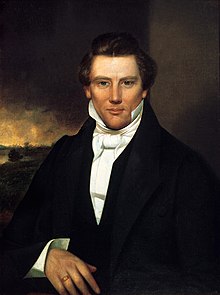| Joseph Smith 1844 presidential campaign | |
|---|---|
 | |
| Campaign | 1844 United States presidential election |
| Candidate | Joseph Smith 1st President of the Church of Christ (1830-1844) 2nd Mayor of Nauvoo, Illinois (1842-1844) Sidney Rigdon First Counselor in the First Presidency Church of Jesus Christ of Latter Day Saints (1833-1844) Second Counselor in the First Presidency Church of Jesus Christ of Latter Day Saints (1832-1833) |
| Affiliation | Reform Party |
| Status | Smith was assassinated prior to the election |
| Headquarters | Nauvoo, Illinois |
| Key people | Willard Richards John M. Bernhisel W.W. Phelps Lucian R. Foster |
| Slogan | Super hanc petram aedificabo |


The campaign of Latter Day Saint movement founder Joseph Smith and his vice presidential running mate, Church of Jesus Christ of Latter Day Saints First Presidency first counselor Sidney Rigdon, took place in 1844. The United States presidential election of that year was scheduled for November 1 to December 4, but Smith was killed in Carthage, Illinois, on June 27. Smith was the first Latter Day Saint to seek the presidency, and the first American presidential candidate to be assassinated.[1]
In 1844, Smith was the mayor of Nauvoo, Illinois, which was then the second most populous city in Illinois with 12,000 residents.[2] Latter Day Saint leaders requested that adherents vote in a bloc behind candidates endorsed by church leaders. As a result, the city's Latter Day Saint residents held the balance of power between the Democrats and Whigs in state elections.[3] Smith also commanded a quasi-public military force, the Nauvoo Legion, that with 2,500 men was almost one-third the size of the U.S. Army.[4] Wicks and Foister argue in Junius and Joseph that political operatives with ties to Smith's Whig opponent Henry Clay were present at events surrounding the raid on the jail where Smith was awaiting trial for treason, among other charges.[5]
In his campaign platform, Smith proposed to gradually end slavery, to reduce the size of Congress, to re-establish a national bank, to annex Texas, California, and Oregon, to reform prisons, and to authorize the federal government to protect the liberties of Latter Day Saints and other minorities.
- ^ "The First Mormon Presidential Candidate". ABC News. 6 December 2007.
- ^ "When Mormons Ruled (June 17, 1956)".
- ^ Luke Perry, Christopher Cronin. "First a Catholic, Then a Mormon?". Mormons in American Politics: From Persecution to Power.
- ^ Bennett, Richard E. Nauvoo Legion in Illinois.
- ^ Susan Sessions Rugh (2006). "Review: Junius and Joseph: Presidential Politics and the Assassination of the First Mormon Prophet by Robert S. Wicks; Fred R. Foister". Brigham Young University Studies. 45 (4). Brigham Young University: 162–164. JSTOR 43044573.